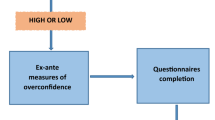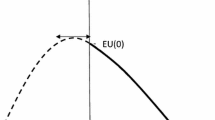Abstract
This experimental study investigates insurance decisions in low-probability, high-loss risk situations. Results indicate that subjects consider the probability of loss (loss size) when they make buying decisions (paying decisions). Most individuals are risk averse with no specific threshold probability.

Similar content being viewed by others
Notes
An alternative explanation could be that subjects behave according to prospect theory in this case they will overestimate the probability in both cases to about the same larger value.
The original instructions are in German. Instructions in English are available upon request.
There is well-established experimental literature (Thaler and Johnson 1999; Plott and Zeiler 2005; Güth and Ortman 2006; Bosman and Winden 2002; Cherry et al. 2002; Bosman et al. 2005) that shows people behave, ceteris paribus, differently if their own earnings are at stake (effort experiment) than they would if a budget was provided to them like a sort of manna from heaven (no-effort experiment). (Perhaps the term ‘non-earned budget’ or ‘gift budget’ is sufficient.)
The required time to complete one session was between 15 and 25 min.
The four situations were randomly ordered and presented to 24 of the subjects, and the reversed random order to the remaining 24 subjects.
The reason for not asking some subjects threshold questions first and then the willingness to pay questions, is that the main aim of the paper is to somehow relate the bids with the threshold probabilities. By asking the threshold questions initially, subjects most probably would have stated very high threshold probability values.
These results do not change if we use the relative WTP.
In case of a small sample size (less then 25) a binomial distribution can be used to obtain the exact distribution form equivalent to the uncorrected form of the McNemar’s test statistic (Sheskin 2004).
Note that the mean threshold probabilities are found to be higher for the subjects who decide to buy the insurance.
References
Arrow KJ (1996) The theory of risk bearing: small and great risks. J Risk Uncertain 12(2/3):103–111
Becker GM, De Groot ME, Marschak J (1964) Measuring utility by a single response sequential method. Behav Sci 9:226–232
Black K (2008) Business statistics for contemporary decision making, 5th edn. Wiley, London
Borling A, Keiding H (2002) Stochastic dominance and conditional expectation-an insurance theoretical approach. Geneva Pap Risk Insur Theory 27:31–48
Bosman R, Sutter M, van Winden F (2005) The impact of real effort and emotions in the power-to-take game. J Econ Psychol 26(3):407–429
Bosman R, van Winden F (2002) Emotional hazard in a power-to-take experiment. Econ J 112(476):147–169
Camerer CF, Kunreuther H (1989) Decision processes for low probability events: policy implications. J Policy Anal Manag 8(4):565–592
Camerer C (1995) Individual decision making. In: Kagel JH, Roth AE (eds) Handbook of experimental economics. Princeton University Press, Princeton, NJ, pp 587–616
Cherry TL, Frykblom P, Shogren JF (2002) Hardnose the dictotar. Am Econ Rev 92(4):1218–1221
Cook PJ, Graham DA (1975) The demand for insurance and protection: the case of the irreplaceable commodity. Draft report, Duke University, North Carolina
Di Mauro C, Maffioletti A (2004) Attitudes to risk and attitudes to uncertainty: experimental evidence. Appl Econ 36:357–372
Dong W, Shah HC, Wong F (1996) A rational approach to pricing of catastrophe insurance. J Risk Uncertain 12(2/3):201–219
Drehmann M, Oechssler J, Roider A (2007) Herding with and without payoff externalities—an internet experiment. Int J Ind Organ 25:391–415
Etchart-Vincent N (2004) Is probability weighting sensitive to the magnitude of consequences: an experimental investigation on losses. J Risk Uncertain 28(3):217–235
Fischbacher U (2007) Zurich toolbox for readymade economic experiments. Exp Econ 10:171–178
Ganderton PT, Brookshire DS, McKee M, Steward S, Thurston H (2000) Buying insurance for disaster-type risks: experimental evidence. J Risk Uncertain 20(3):271–289
Greiner B (2004) The online recruitment system ORSEE 2.0 - A guide for the organization of experiments in economics. In: Kremer K, Macho V (eds) Forschung und wissenschaftliches Rechnen 2003. GWDG Bericht 63, Göttingen : Ges. für Wiss. Datenverarbeitung. No. 10. University of Cologne, pp 79–93
Grether DM, Plott CR (1979) Economic theory of choice and the preference reversal phenomenon. Am Econ Rev 69(4):623–638
Güth W, Ortman A (2006) A behavioral approach to distribution and bargaining. In: Altman M (ed) Handbook of contemporary behavioral economics: foundations and developments. Sharpe ME, New York
Harbaugh W, Krause K, Vesterlund L (2002) Prospect theory in choice and pricing tasks. University of Oregon, Economics Department, Working papers, 27
Hershey JC, Schoemaker PJH (1980) Risk taking and problem context in the domain of losses: an expected utility analysis. J Risk Insur 47(1):111–132
Hey JD, Lee J (2005) Do subjects separate (or are they sophisticated)? Exp Econ 8:233–265
Hey JD, Morone A, Schmidt U (2009) Noise and bias in eliciting preferences. J Risk Uncertain 39(3):213–235
Holt CA (1986) Preference reversals and the independence axiom. Am Econ Rev 76(3):508–515
Kagel JH, Roth AE (1995) The handbook of experimental economics. Princeton University Press, Princeton, NJ
Kahneman D, Tversky A (1979) Prospect theory, an analysis of decision under risk. Econometrica 47:263–291
Kuhn KM, Budescu DV (1996) The relative importance of probabilities, outcomes, and vagueness in hazard risk decisions. Organ Behav Hum Decis Process 68(3):301–317
Kunreuther H, Slovic P (1978) Economics, psychology, and protective behavior. Am Econ Rev 68:2. Papers and proceedings of the ninetieth annual meeting of the American Economic Association, pp 64–69
Laury SK (2006) Pay one or pay all: random selection of one choice for payment. http://expecon.gsu.edu/workingpapers/GSU_EXCEN_working_paper_2006-24.pdf
Machina MJ, Pratt JW (1997) Increasing risk: some direct constructions. J Risk Uncertain 14:103–127
McClelland GH, Schulze WD, Hurd B (1990) The effect of risk beliefs on property values: a case study of a hazardous waste site. Risk Anal 10(4):485–497
McClelland GH, Schulze WD, Coursey DL (1993) Insurance for low-probability hazards: a bimodal response to unlikely events. J Risk Uncertain 7:95–116
McDaniels TL, Kamlet MS, Fischer GW (1992) Risk perception and the value of safety. Risk Anal 12(4):495–503
Morgenstern O (1979) Some reflections on utility theory. In: Allais M, Hagen O (eds) The expected utility hypothesis and the Allais paradox. D. Reidel, Dordrecht
Morone A (2010) On price data elicitation: a laboratory investigation. J Socio-Econ 39(5):540–545
Müller A (1998) Comparing risks with unbounded distributions. J Math Econ 30:229–239
Noussair C, Robin S, Ruffieux B (2004) Revealing consumers’ willingness-to-pay: a comparison of the BDM mechanism and the Vickrey auction. J Econ Psychol 25:725–741
Plott CR, Zeiler K (2005) The willingness to pay- willingness to accept gap, the “endowment effect”, subject misconceptions, and experimental procedures for eliciting valuations. Am Econ Rev 95(3):530–545
Pommerehne WW, Schneider F, Grether P, Plott CR (1982) Economic theory of choice and the preference reversal phenomenon: a reexamination/reply. Am Econ Rev 72(3):569–576
Rothschild M, Stiglitz JE (1970) Increasing risk: I. A. definition. J Econ Theory 2:225–243
Safra Z, Segal U, Spivak A (1990) The Becker–DeGroot–Marschak mechanism and nonexpected utility: a testable approach. J Risk Uncertain 3(2):117–190
Schade C, Kunreuther HC, Koellinger P (2012) Protecting against low-probability disasters: the role of worry. J Behav Decis Mak 25:534–543
Segal U (1988) Does the preference reversal phenomenon necessarily contradict the independence axiom? Am Econ Rev 78(1):233–236
Sheskin DJ (2004) Handbook of parametric and nonparametric statistical procedures, 3rd edn. Chapman & Hall, Boca Raton
Sjöberg L (1999) Consequences of perceived risk: demand for mitigation. J Risk Res 2(2):129–149
Slovic P, Fischhoff B, Lichtenstein S, Corrigan B, Combs B (1977) Preference for insuring against probable small losses: insurance implications. J Risk Insur 44(2):237–258
Slovic P, Fischhoff B, Lichtenstein S (1980) Societal risk assessments: how safe is safe enough? In: Schwing RC, Albers W Jr (eds) Facts and fears: understanding perceived risk. Plenum Press, New York
Starmer C, Sugden R (1991) Does the random-lottery incentive system elicit true preferences? An experimental investigation. Am Econ Rev 81(4):971–978
Thaler RH, Johnson EJ (1999) Gambling with the house money and trying to break even: the effects of prior outcomes on risky choice. Manag Sci 36(6):643–660
Tversky A, Slovic P, Kahneman D (1990) The causes of preference reversal. Am Econ Rev 80:204–217
Tversky A, Sattath S, Slovic P (1988) Contingent weighting in judgment and choice. Psychol Rev 95:371–384
Tversky A, Kahneman D (1981) The framing of decisions and the psychology of choice. Science 221:453–458
Author information
Authors and Affiliations
Corresponding author
Rights and permissions
About this article
Cite this article
Ozdemir, O., Morone, A. An experimental investigation of insurance decisions in low probability and high loss risk situations. J Econ Interact Coord 9, 53–67 (2014). https://doi.org/10.1007/s11403-013-0112-2
Received:
Accepted:
Published:
Issue Date:
DOI: https://doi.org/10.1007/s11403-013-0112-2




